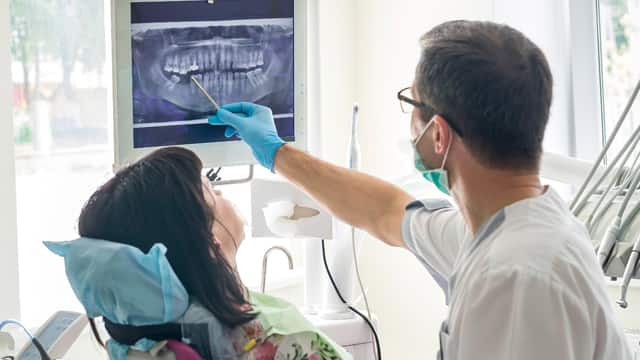TMJ Disorder Overview
To understand TMJ disorders, it’s best to break down some of the associated terms that can otherwise confuse. TMJ refers to your temporomandibular joints that enable your ability to move your jaw, chew, speak, and swallow.
TMJ disorders are a specific type of temporomandibular disorder (TMD) in which the joints are affected. This can include dysfunction to the joint itself (a disc, ball, and socket) or the associated ligaments, muscles, and bone.
The Cleveland Clinic notes that TMJ can be temporary or a chronic problem. Men are more likely to have this condition than women, and you’re most likely to develop it between 20 and 40.
TMJ disorders are caused by:
- Chronic grinding of your teeth (often from stress)
- Problems with alignment of your jaw or teeth
- Connective tissue disease
- Injury or dislocation
- Inherited genetics
- Arthritis
Helpful tip: The cause of TMJ disorders is often the result of a combination of risk factors, and that the cause for many is unknown.
Symptoms and Diagnosis
It’s essential to receive professional diagnosis and treatment recommendations for any medical problem, especially TMJ disorders. Many of the symptoms of these disorders can overlap with those of other conditions, so it can be difficult to diagnose accurately.
TMJ disorder symptoms may include:
- Pain, discomfort, or sensitivity around your ears, jaw, or temporomandibular joints (TMJ)
- Aches in your head, neck, or teeth
- Problems or discomfort while eating and chewing
- Difficulty opening and closing your mouth due to locking of your temporomandibular joints (TMJ)
- Clicking, popping, or grating sounds when opening your mouth or chewing
- Fatigue, swelling, or pain in your face
- Limited range of motion of your jaw or mouth
- Earaches and hearing problems
- Dizziness
It’s a great idea to visit your dental or medical professional for expert diagnosis and treatment advice. According to the Mayo Clinic, to help determine the source of the problem, they may:
- Perform an examination to determine your jaw’s range of motion, identify the areas causing discomfort, and observe your jaw as it opens and closes.
- Recommend dental x-rays, CT scans, or an MRI to see the structure of your jaw and teeth.
Treatment Options
Research on TMJ treatment is still emerging. Because of this, it’s wise first to consider the safest approaches possible that don’t have associated risks or cause permanent changes to your body.
There’s a wealth of options available to try before resorting to more extreme measures like surgery and other procedures. In fact, some of the best treatments at your disposal include simply doing less to irritate your TMJ! Those without associated pain likely don’t require treatment.
Conservative Treatments
There are great starting places to help treat your TMJ disorder and reduce your symptoms:
- Avoid gum, biting your nails, and difficult-to-chew foods in favor of soft foods
- Skip out on large movements to your jaw like yelling and loud singing
- Practice proper posture, especially when seated at a computer
- Perform exercises recommended by your dental or medical professional to strengthen or relax your jaw
- Build a routine of stress reduction and relaxation, especially before bed if you grind your teeth
- Wear a mouthguard (also called a night guard) for sleep to reduce the effects of grinding
- Apply heat (for 5 minutes) or cold (for 10 minutes) to the side of your face multiple times a day
- Consider prescription or over-the-counter medication to manage pain, swelling, or anxiety
Important note: It’s vital to follow the recommendation of your dental or medical professional. Only take medications as instructed on the packaging and as prescribed.
Other Treatments
Because many of the more aggressive treatments are not reversible, it’s a good idea to seek a second or third opinion from another medical or dental professional. There are various other treatment options available when more conservative approaches have proven ineffective.
Other treatment options for TMJ disorders may include:
- Therapy using radio wave therapy, trigger-point injections, ultrasound, or electrical currents.
- Procedures such as open-joint surgery, arthrocentesis, arthroscopy, or dental restoration to fix your bite.
TMJ disorders can be unpleasant and stressful, but rest assured that they are a wide range of treatment options. Your best bets are avoiding jaw irritation in the first place, stress reduction, and checking in with your dental or medical professional for their expert opinion. You're now more prepared and informed than ever to manage your symptoms.
This article is intended to promote understanding of and knowledge about general oral health topics. It is not intended to be a substitute for professional advice, diagnosis or treatment. Always seek the advice of your dentist or other qualified healthcare provider with any questions you may have regarding a medical condition or treatment.
ORAL HEALTH QUIZ
What's behind your smile?
Take our Oral Health assessment to get the most from your oral care routine
ORAL HEALTH QUIZ
What's behind your smile?
Take our Oral Health assessment to get the most from your oral care routine
This article is intended to promote understanding of and knowledge about general oral health topics. It is not intended to be a substitute for professional advice, diagnosis or treatment. Always seek the advice of your dentist or other qualified healthcare provider with any questions you may have regarding a medical condition or treatment.
Join Us
Get the best of your oral health routine and take it to the next level with expert advice, recommendations, products and solutions and special offers.
Join Us
Get the best of your oral health routine and take it to the next level with expert advice, recommendations, products and solutions and special offers.















